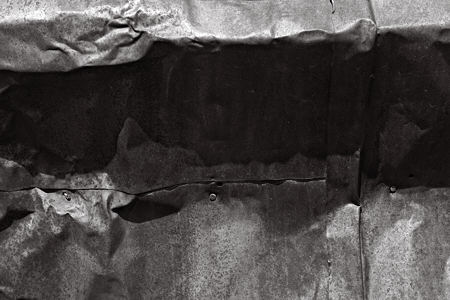
I revisited one of the places I like to photograph and came back with, among others, the image shown above. No, it was not the scene of junkyard treasure, and this is not the side of a beat-up old car. It’s actually from my ghost town site, and it’s the side of a beat-up old outhouse. I guess I took it because I tend to like abstracts like this. Though that’s probably not the whole story, because this is the only abstract I made in hours of photographing in a place loaded with weathered wood, ancient mining equipment, etc. Perhaps I was drawn to it through mysterious workings of my unconscious. If so, I discovered why the next day — but maybe you can guess it now?
When I fired up my computer and started processing this one, after a few steps I started playing with orientation. The first new one I tried worked for me:
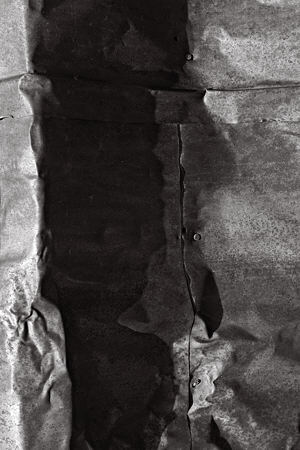
If you don’t see why, look at the vase picture from Karl’s post yesterday.
This is not the first time this has happened to me. In fact, one of the very few (two) other shots I have in the popular “rusted metal” genre is this one:
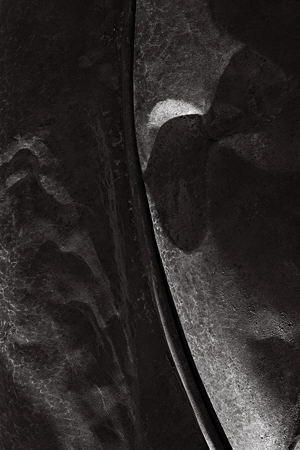
which in its native orientation was a fender like this:
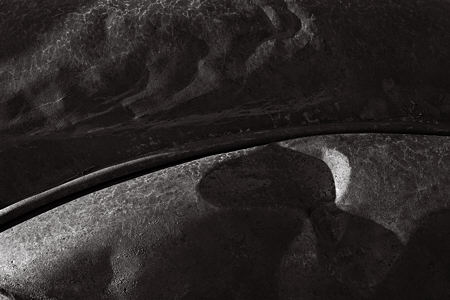
I can only speculate that my fusiform gyrus works overtime, straining to recognize faces even where the rest of my brain knows there’s no face. Does some subliminal firing tells me to make a picture, even as my conscious brain invents another reason? At any rate, it’s beginning to look like a pattern.
How far might that pattern reach? I’m wondering if there is some connection to the semi-abstract waterfall image seen here before. With dark flanking bright, it’s the inverse of the image I started this post with. But no, here I cannot make out any kind of face, no matter how I rotate it. Still, there’s something about those shapes, which I can’t call anthropomorphic, but… Anyway, I know it’s not just me — this was my first sale at the gallery I’m now working with.
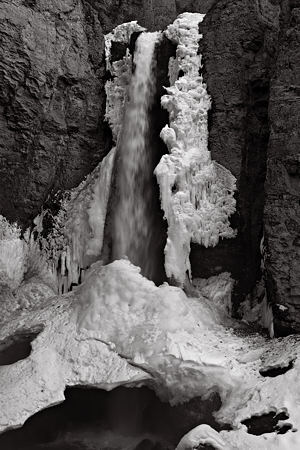
I believe that subliminal activity in our minds has a lot to do with what we find ourselves attracted to, visually and otherwise. I suspect the changing nature of that unconscious background has a lot to do with Karl’s post. Some things do become clear with time, but I don’t know if I’ll ever understand why I like that Yellowstone waterfall.

Steve,
Three years back I dragged my family to Dia:Beacon and remember being castigated for the meaninglessness of modern art by members of my family (the echoes of which reverberate even today). What I would not forget was the numerous times I was drawn to the John Chamberlain sculptures and myriad shapes that I saw in the twisted hunks of ‘found automobile parts’ that he created seemingly at random but had a unified beauty that I could not describe adequately. The picture of the rusted automobile just bought back that moment for me.
It’s catching!!! – I took a recent photo which is called Baking Tray Blues – the colours and shapes on the underside of a wet baking tray had me jumping for the camera!
Maybe it’s part of my continued development into the world of blue and it’s effect on our inner being as a colour.
Anyway Steve (yes I’m back to comment after a spell in the studio!) I really appreciate what can happen during the orientation of a picture – I actually rotate my canvas many times when painting.
Mark,
I’m surprised to learn a painter also tries different orientations. Even though your paintings are quite abstract, there is still a lot of reference to real world objects, such as people, bicycles, etc. Do you look at different orientations to get a better sense of how to distribute color, or do you actually sometimes change the orientation from an earlier stage, before oriented referents are introduced?
Steve
I use varied orientations to allow different brush stroke directions that create the colour and abstraction effects I try to achieve. It sometimes helps me to focus on the location of dark and light tones. It also helps me to work with the location and relationship of colours from different perspectives rather than being distracted by trying to get shapes right initally. Sometimes viewing the same image from a different perspective somehow helps me see if it all hangs together on the actual orientation of the picture.
Orientation can have a radical effect on the way a picture looks. I sometimes find that a painting of a head or face looks better upside-down. At first I thought it was an effect of a novel view. Later I realized, or came to suspect at least, that it had to do with interpretations of gravity. What might seem heavy in the right-side up view would seem to float upward in the upside-down view.